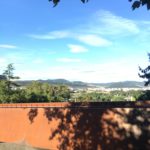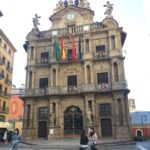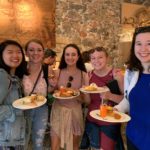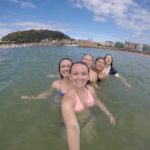¡Buenas!
I am writing from Pamplona, Spain, where we’ve been for a week. Our days have been packed with classes, fun cultural excursions, and lots of amazing food.
We are taking an extensive Spanish language and culture course at the Universidad de Navarra to prepare us to live in our host cities. The university is absolutely gorgeous, with a lot of trees, rolling hills, and beautiful architecture. The language barrier is difficult, but the class has definitely helped me work on my grammar, learn new vocabulary, and become more confident speaking Spanish with native speakers.
We have spent a lot of our time walking around and exploring the city. The Old City (or the “Casco Viejo”) is especially beautiful, and its cobblestone streets are always bustling with people. On one walking tour, we stopped for sangria and then drank it in the middle of the street (eating and drinking in the street is very common here because the bars are so small!) We’ve spent a lot of time shopping in the Old City and even took a Rumba Flamenco class!
On one of our first days in Pamplona, we had a tour of the Plaza de Toros de Pamplona, one of the main sites of the annual “running of the bulls.” The tradition began in the 14th century, when men would speed up the process of transporting bulls to the markets by using various fear tactics. This practice quickly evolved into a competition, as young men tried to race the bulls to their pens. We learned that the bulls are raised on farms in southern Spain and transported to Pamplona when they are about five years old. They are then forced to run the encierro and are killed (they usually are stabbed around 20 times before they die).The extreme physical and psychological abuse of the bulls obviously makes the event very controversial, and some of our tour guides even said that they are so against it that they refuse to attend.
We also visited San Sebastián, a seaport city located about 10 miles from the French border. It is the capital of the province of Guipúzcoa in the Basque country–all of the street signs are in both Spanish and Basque! We hiked to the top of a mountain trail called Sendero de San Teresa, from which we were able to see the entire city. We then ate tapas for lunch (or pintxos, as people in Basque country call them) and went for a refreshing swim in the ocean.
This weekend, we drove to Loyola, where we toured the Sanctuary of Loyola, or the birthplace of St. Ignatius, the founder of the Society of Jesus. We went to mass in the basilica and enjoyed the picturesque views of the Montserrat mountains (which brought back special memories for us Holy Cross students!)
We also went to Bilbao, which is about three hours north of Pamplona, and toured the Guggenheim.

It’s crazy that we’ve only been in Spain for a week–it already feels like we’ve been here for months! I’m very excited to continue to improve my Spanish before I move to Coruña and meet my host family. Every single person who we’ve met here has been so kind and encouraging when we speak Spanish, even when what we say makes no sense!
¡Hasta luego (or “sta-lo-go” as people say it here)!




































